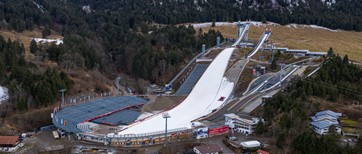
Photo credit: “Ski jumping in Oberstdorf, Germany” by Arne Müseler
“Having the World Cup back on U.S. soil is very important in developing the sport of Ski Jumping in this country and across the world,” enthuses one ski jumping trainer about the return of the Men’s Ski Jumping World Cup to historical site Lake Placid, NY, after over three decades. As heart-warming as this news may be for North American winter sports aficionados, it’s hard to feel as optimistic about ‘developing’ the future of snow sports when climate change is already heavily impacting events even today.
It’s February 2023. The Nordic World Ski Championships in Planica, Slovenia, are in full swing. It’s 2.5°C warmer than on average at this time of year, and the TV reporter says it feels like spring up there in the Alps. But there’s plenty of snow prepared and stored to be used in the competitions. “Good,” I think. I’ve been looking forward to the ski jumping events for weeks, and I know that many athletes have been working towards this particular championship for years.
Within five minutes, I’ve gone from being genuinely terrified by the ongoing climate crisis to feeling happily excited at the prospect of watching winter sports with a fake winter wonderland backdrop. This cognitive dissonance has become the usual state of mind for many of my decisions and activities. From disposable coffee cups to debatable car rides to vast digital streaming libraries, there’s always the option to avoid another drain on resources.
It’s a champagne problem exemplifying the daunting universal truth: There won’t be any World Cups held on a wrecked planet. The logistics efforts to host such an event are enormous: from erecting structures that change the face of entire mountainsides to the amounts of energy needed for the preparation and maintenance of winter sports locations where natural and artificial ice and snow have to be continuously cooled down in temperatures far above the freezing point. How long can we continue to contribute to global warming without coming up with long-term sustainable alternatives?
Alternative materials and changed schedules and locations aren’t actual solutions. Winter sports organizations and audiences must use their platforms and resources to promote climate change awareness and push for systemic change. If the latest news on climate change action on the FIS (Fédération Internationale de Ski) website addresses athletes’ concerns that the governing body for international skiing and snowboarding isn’t doing nearly enough to counter global warming, then celebrating additional venues for future events feels naive at best.
It’s emblematic that on the FIS website you’ll find a Bring Children to the Snow section but nothing on climate protection. Affected euphoria and euphemism won’t change the obvious fact, though: Can’t bring the children to the snow without bringing the snow to the children.
5,605 Total Views, 7 Views Today






